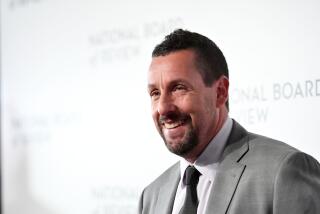Classic Hollywood: counterculture road films
As a film genre, the road movie has proved to be as durable as any in Hollywood history. Perhaps that’s because it’s always being re-interpreted to fit the mood of the times and can be mined for both comic (“Sullivan’s Travels,” “Planes, Trains and Automobiles”) and dramatic ( “The Road,” “Rain Man”) potential.
Road movies were especially prevalent during the Great Depression, including 1933’s “Wild Boys of the Road” and 1940’s “The Grapes of Wrath,” as millions of Americans left home in search of a better life. During the counterculture ea of the late 1960s and early ‘70s, road movies such as 1969’s “Easy Rider” and “Alice’s Restaurant” became touchstones for a generation.
“These movies from the ‘70s are about people who hit the road in order to search for something either because they are unhappy and alienated so there is nothing to do but drift,” notes Ian Birnie, the head of the Los Angeles County Museum of Art’s film program.
Screenwriter Larry Karaszewski believes road movies enjoy a renaissance when “there is a social, political or economic upheaval. Maybe it is because being on the road you are neither here nor there — you are sort of homeless in a weird way.”
For Monte Hellman, who directed the 1971 cult road flick “Two-Lane Blacktop,” any film worth its salt is, in essence, a road movie. “‘La Strada’ is a road movie,” he says of the Federico Fellini classic. In fact, Hellman says all the films he’s directed including his offbeat westerns, 1967’s “The Shooting” and 1965’s “Ride in the Whirlwind,” are road movies.
“One of my inspirations was a film writer, Siegfried Kracauer, who wrote a book called ‘Theory of Film,’” Hellman says. “His main theory was that the only valid subject matter or milieu for a movie was the street — otherwise it was theater.”
Hellman will be on hand to discuss “Two-Lane Blacktop” when the film screens Jan. 21 as part of LACMA’s new film series “True Grit: The Golden Age of Road Movies,” which opens Friday with 1970’s “Five Easy Pieces” and 1972’s “Play It as it Lays.” The series, which coincides with the LACMA exhibition “William Eggleston: Democratic Camera,” features 11 classic road movies from the counterculture era. The choices reflect the restlessness and rebellion of that time, including Arthur Penn’s seminal 1967 “Bonnie and Clyde,” the cultural phenomenon “Easy Rider” and the underrated 1973 “Scarecrow,” which starred Gene Hackman and Al Pacino.
“There is a generational aimlessness that manifests itself in these films,” notes Bernardo Rondeau, film coordinator at LACMA. “These films create intentionally or unintentionally a very vibrant snapshot of America as it was at that moment.”
Though most of these movies in the festival revolve around twentysomethings, Paul Mazursky’s 1974 “Harry & Tonto,” about an elderly man ( Art Carney), will screen Jan. 13. Carney won an Oscar for playing Harry, who loses his New York apartment and sets out on the road with his cat; director Mazursky will appear at the screening.
A lot of the films tanked upon release but have gained respect and found an audience over the decades, like “Two-Lane Blacktop,” starring James Taylor and Dennis Wilson as a driver and a mechanic who are challenged to a cross-country race by a man (Warren Oates) in a yellow GTO. They head out in their 1955 Chevy and are eventually joined by a young woman (Laurie Bird) they meet at a diner.
“Two-Lane Blacktop” was one of five pictures, including Peter Fonda’s “The Hired Hand” and Dennis Hopper’s “The Last Movie,” that were made under the reign of Universal vice president Ned Tanen. “He was given the go-ahead to start this program trying to imitate the success of ‘Easy Rider,’” Hellman says.
“The idea was let’s give these young people a little freedom and see what they come up with. Lew Wasserman, who was the head of the studio, didn’t believe that idea, but he let Ned have a try at it. Wasserman didn’t want them to succeed, and they didn’t succeed.”
It was Robert Redford who helped resurrect the film years later. “I was part of a group of people from Hollywood who went to Sundance to be advisors to various workshops,” Hellman says. “He wanted to show ‘Two-Lane Blacktop.’ All the prints had been destroyed, so he got Universal to make a new print. Once they had the print, people wanted to see it, and it started playing around. That was the beginning.”
“Easy Rider” star Peter Fonda’s father, Henry, appeared in what immortal 1940 road movie?
“The Grapes of Wrath”
More to Read
Only good movies
Get the Indie Focus newsletter, Mark Olsen's weekly guide to the world of cinema.
You may occasionally receive promotional content from the Los Angeles Times.







